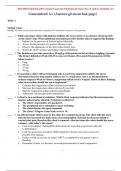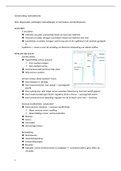-
1. Examen - Community health exit hesi updated- & community proctored a+ complete latest
-
2. Examen - Test bank of hesi maternity ob exam version 2,test questions and answers (a+ grade) l...
-
3. Examen - Nur community quizlet hesi exit 1 questions and answers latest update 2023-2024 rated...
-
4. Examen - Hesi mental health rn questions and answers from v1-v3 test banks and actual exams (l...
-
5. Examen - Hesi pediatrics v1, v2 & v3 2023 rn latest a+ verified answer
-
6. Examen - Hesi mental health rn questions and answers from v1-v3 test banks from actual exams 2...
-
7. Examen - Hesi exit exam 2023 version 1 test bank
-
8. Examen - Hesi critical care test bank rn updated a+
-
9. Examen - Test bank for pn hesi exit exam 2022 version 1, version 2, version 3 updated a+
-
10. Examen - community health rn v3 exit hesi guaranteed a+ tb guide (all 160 q&a)
-
11. Examen - 2023 community health rn v2 exit hesi guaranteed a+ tb guide (all 160 q&a)
-
12. Examen - Critical care hesi exit exam (v1) test bank guide 100% correct answers guaranteed a+
-
13. Examen - Hesi a2 critical thinking 2023 questions and updated 100% correct answers/ a+ grade
-
14. Examen - Test bank for chemistry and physics for nurse anesthesia 3rd edition shubert a+
-
15. Examen - Hesi health assessment nursing rn v1 100 questions with answers 2023
-
16. Examen - Hesi exit exam (15 latest versions, 2500 + q & a, 2023)/ exit hesi exam |verified and...
-
17. Examen - Hesi rn exit exam 2022 version 1 (v1) – all 160 questions & answers!! (actual scree...
-
18. Examen - 2023 pn hesi exit exam - 2023 questions and correct verified answers2023 questions an...
-
19. Examen - 2023 hesi exit exam hesi review over 700 questions answers to the hesi exit exam a+
-
20. Examen - 2023 hesi exit rn exam v1-v7 150 out of the 160 total questions for each versio a+
-
21. Examen - Pn hesi exit v1 & v2 latest 2023 exam/ hesi pn v1 & v2 latest exam 361 real exam ques...
-
22. Examen - Hesi fundamentals exam-with 100% verified answers- 2023
-
23. Examen - 2023 hesi pediatric (peds) exit exam version 1 and 2 (v1 & v2) - all q&as (brand new)...
-
24. Examen - All hesi fundamentals exam test bank updated 2023 a+
-
25. Examen - 2023 ngn rn hesi exit exam - version 1 (v1) all 160 qs & as included - guaranteed pas...
-
26. Examen - Hesi rn- critical care-2023 critical care hesi exit exam real exam (all 55 q&a) 100%...
-
27. Examen - Rn hesi exit exam versions v1, v2, v3, v4, v5, v6, v7, v8, v9 & v10 (all 1580 questio...
-
28. Examen - 2023 hesi exit exam: version 1 (v1) – next gen (ngn) format - all 130 q&a included!...
-
29. Examen - 2023 critical care hesi exit exam (v1) test bank guide (all 55 q&a) 100% correct a+
-
30. Examen - 2023 hesi rn med surg exam v2 study guide notes test bank & screenshots w/ answers a+
-
31. Examen - 2023 hesi med surg exit exam (v1 version 1) brand new q&as + guaranteed a+
-
32. Examen - 2023 critical care hesi exit version 2 (v2) test bank guide (all 55 questions & answe...
-
33. Examen - 2023 hesi ob maternity tb questions & answers (pics) included!! version 1 (v1) guaran...
-
34. Examen - 2023 hesi med surg questions / answers a+
-
35. Examen - Hesi a2 v2 questions and answers a+
-
36. Examen - Hesi a2 v2 questions and answers grammar, vocabulary, reading comprehension, math, a&...
-
37. Examen - Hesi a2 v2 biology exam-with 100% verified solutions-2023-2024 a+
-
38. Examen - Hesi a2 entrance exam all section questions & answers latest update| 92% featured in ...
-
39. Examen - Hesi a2 entrance exam 2023 hesi vocabulary a+
-
40. Examen - 2023/2024 hesi leadership & management exam version 1 & 2 a+
-
41. Examen - Hesi a2 reading comprehension 2023 latest exams a+
-
42. Examen - Hesi a2 entrance exam (hesi a2) biology and anatomy 2023/2024 a+
-
43. Examen - Hesi a2 latest version all subjects covered a+ 2024
-
44. Examen - Hesi a2 (nursing admission test) 2023 vocabulary a+
-
45. Examen - Hesi a2 anatomy and physiology exam solutions 2023 a+
-
46. Examen - Hesi biology and anatomy study guide latest a+
-
47. Examen - Hesi a2 chemistry exam 2023 a+
-
48. Examen - Hesi a2 reading - exam updated a+
-
49. Examen - Hesi a2 biology (100 questions and answers) a+ 2023
-
50. Examen - Hesi a2 exam reading compehension a+ 2023
-
51. Examen - 2023 hesi exit v7 latest actual exam 150+ questions and correct answers a+
-
52. Examen - 2023 pn hesi exit exam nurs pn exam hesi questions with answers 2023 update graded a...
-
53. Examen - 2023 hesi pn exit (new) and updated a+ 100%
-
54. Examen - Hesi exit exam v1 latest a+ 2023
-
55. Examen - 2023 hesi exit exam: version 1 (v1) all 130 q&a included! guaranteed a++
-
56. Examen - Hesi maternity exam 2023 a+ latest & updated
-
57. Examen - 2023 hesi ob maternity version 1 (v1) exit exam (all 55 qs) tb w-pics included!! a+
-
58. Examen - 2023 hesi ob maternity version 1 (v1) exit exam (all 55 qs) tb w/pics included!! a+
-
59. Examen - 2023 hesi biology latest exam version 2023 a+ nursing
-
60. Examen - 2023 hesi a2 exam v1 with a+ graded answers top-rated document with perfect rationale...
-
61. Examen - 2023 hesi a2 critical thinking latest update 2023 a+
-
62. Examen - 2023 hesi dosage calculations practice exam, hesi pharmacology review a+
-
63. Examen - 2023 hesi community 2 a+ latest and updated 2023
-
64. Examen - 2023 hesi medical surgical (med surg)exit exam version 2 (v2) all 55 q&a a+ guaranted...
-
65. Examen - 2023 hesi fundamentals v2 questions and answers guaranteed grade a+
-
66. Examen - 2023 critical care hesi exit exam (v2) version 2 test bank guide (all 55 q&a) 100% co...
-
67. Examen - 2023 2024 all hesi fundamentals exam test bank updated question & answers a+
-
68. Examen - 2023 hesi leadership & management exam version 1 & 2 (v1-v2) (actual screenshots from...
-
69. Examen - 2023 hesi leadership exit exam v1 & v2 tb guide (brand new!!) a+ all q&as included!!
-
70. Examen - 2023 hesi med surg version 1 (v1) exit exam – brand new q&as! guaranteed pass w/a+ ...
-
71. Examen - Hesi exit rn exam-756 qa, hesi exit rn exam (version 1 to version 7) a+
-
72. Examen - 2023 hesi mental health rn v1-v3 test banks (all together) – brand new!! guarantee...
-
73. Examen - Lhesi mental health rn v1-v3 2023 test bank a+ latest and updated
-
74. Examen - 2023 hesi pharmacology (pharm) exam version 1 (v1) brand new q&as guaranteed pass w/a...
-
75. Examen - 2023 hesi med-surg rn custom exam (for med surg ) pics & q&as a+++++
-
76. Examen - 2023 hesi med-surg rn custom exam (for med surg ii class) pics & q&as included (a+)
-
77. Examen - 2023 rn hesi exit exam - version 1 (v1) all 160 qs & as included - guaranteed pass a+...
-
78. Examen - Hesi ob peds exam 2023 test bank (revised) 2 versions each with 55 questions with ver...
-
79. Examen - Hesi a2 version 2 grammar vocab reading math latest and updated a+
-
80. Examen - Hesi version 2(v2) exit exam with 100% correct answers latest 2024
-
81. Examen - 2023 hesi mental health rnv1-v3 test banks (all together) – brand new!! guaranteed...
-
82. Examen - 2023 hesi dosage calculations practice exam, hesi pharmacology review a+
-
83. Examen - 2023-2024 hesi rn exit exam v3 full 160 questions 2024 a +
-
84. Examen - Hesi exit exam test bank latest and updated a+
-
85. Examen - Hesi inet rn exit exam v2 q & a screenshots: 2023 edition a+
-
86. Examen - Hesi exit rn exam over 700 questions answers rationale new 2023 2024 latest. a+
-
87. Examen - Bsn hesi 266 medical surgical exam updated with 2023 2024 questions and correct answe...
-
88. Examen - Hesi medical surgical exam updated with 2023 2024 questions and correct answers a+
-
89. Examen - Hesi review #1 bsn 266 med surgical test bank 2024 a+
-
90. Examen - Hesi milestone 2 actual exam 3 latest versions (v1, v2 and v3) 2023-2024 each version...
-
91. Examen - Hesi a2 entranceh exam all subject questions answers latestupdate featured in the rea...
-
92. Examen - Hesi med surg exit exam 2 newest version�with 100% verified answers 2024 a+
-
93. Examen - 2024 hesi rn med surg exam v2 study guide notes test bank & screenshots w/ answers a+
-
94. Examen - Bsn hesi 266 med surg exam latest fall 2023/2024 updated questions and verified answe...
-
95. Examen - Bsn hesi 266 med surg exam latest fall 2023/2024 updated questions and verified answe...
-
96. Examen - Hesi health assessment latest 2024 test bank real exam 500+ questions with complete ...
-
97. Examen - Hesi mental health rn questions and answers from v1-v3 test banks and actual exams (...
-
98. Examen - Hesi exit rn 2024 v3 160 questions & answers latest a+
-
99. Examen - Hesi exit exam test bank 2023-2024 med surg hesi exit exam/latest a+
-
100. Examen - Exit hesi test bank (over 1000 q's and answers ) spring 2023 / exit hesi prep distinc...
-
Montrer plus





